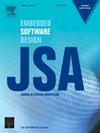通过监控和分析驱动的边缘协调来管理实时限制因素
IF 3.7
2区 计算机科学
Q1 COMPUTER SCIENCE, HARDWARE & ARCHITECTURE
引用次数: 0
摘要
新兴的实时应用程序越来越多地转向分布式异构平台,在更强大和灵活的资源能力的承诺下。这种转变不可避免地带来了新的挑战。部署线程链的设计空间更加复杂,对最坏情况执行时间的可靠估计也更难获得。此外,环境更加动态,需要应用程序本身具有额外的运行时灵活性。在本文中,我们提出了一种基于优化的方法来解决这个问题。首先,我们提出了现代分布式边缘应用的模型和实时分析。其次,我们提出了一个设计时优化问题,以显示如何从时间可预测性的角度设置表征此类应用的主要参数。然后,我们提出了一个编排和运行时决策机制,该机制监视执行时间并允许运行时重新配置,从优雅的降级策略到工作负载的重新分配。本文最后以基于QNX RTOS的代客泊车系统为例,对该方法进行了原型实现,并对基于边缘的代客泊车应用进行了评估。本文章由计算机程序翻译,如有差异,请以英文原文为准。
Managing real-time constraints through monitoring and analysis-driven edge orchestration
Emerging real-time applications are increasingly moving to distributed heterogeneous platforms, under the promise of more powerful and flexible resource capabilities. This shift inevitably brings new challenges. The design space to deploy chains of threads is more complex, and sound estimates of worst-case execution times are harder to obtain. Additionally, the environment is more dynamic, requiring additional runtime flexibility on the part of the application itself. In this paper, we present an optimization-based approach to this problem. First, we present a model and real-time analysis for modern distributed edge applications. Second, we propose a design-time optimization problem to show how to set the main parameters characterizing such applications from a time-predictability perspective. Then, we present an orchestration and runtime decision-making mechanism that monitors execution times and allows for runtime reconfigurations, spanning from graceful degradation policies to re-distributions of workload. A prototypical implementation of the proposed approach based on the QNX RTOS and its evaluation on a realistic case study based on an edge-based valet parking application conclude the paper.
求助全文
通过发布文献求助,成功后即可免费获取论文全文。
去求助
来源期刊

Journal of Systems Architecture
工程技术-计算机:硬件
CiteScore
8.70
自引率
15.60%
发文量
226
审稿时长
46 days
期刊介绍:
The Journal of Systems Architecture: Embedded Software Design (JSA) is a journal covering all design and architectural aspects related to embedded systems and software. It ranges from the microarchitecture level via the system software level up to the application-specific architecture level. Aspects such as real-time systems, operating systems, FPGA programming, programming languages, communications (limited to analysis and the software stack), mobile systems, parallel and distributed architectures as well as additional subjects in the computer and system architecture area will fall within the scope of this journal. Technology will not be a main focus, but its use and relevance to particular designs will be. Case studies are welcome but must contribute more than just a design for a particular piece of software.
Design automation of such systems including methodologies, techniques and tools for their design as well as novel designs of software components fall within the scope of this journal. Novel applications that use embedded systems are also central in this journal. While hardware is not a part of this journal hardware/software co-design methods that consider interplay between software and hardware components with and emphasis on software are also relevant here.
 求助内容:
求助内容: 应助结果提醒方式:
应助结果提醒方式:


